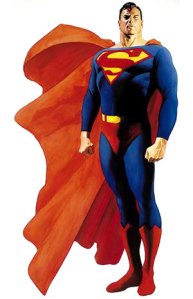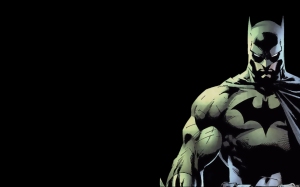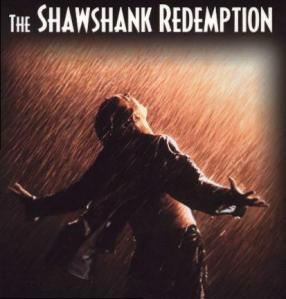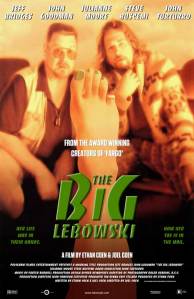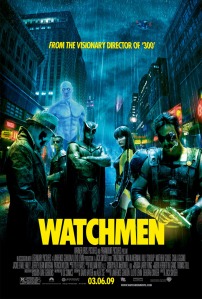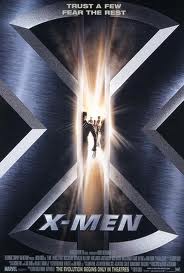To admit to liking superhero comics is akin to confessing a hideous social disease. They are the core of the geek’s domain, loved by spotty, greasy man-boys who live in their parent’s basement and masturbate to pictures of Katee Sackhoff and Tricia Helfer (they’ve moved on from Sarah Michelle Gellar). These borderline autistic creatures spend all day on internet chatrooms or World of Warcrack, having no real-world social skills, and live for the day that they can dress up as their favourite superhero and cruise the halls of the local convention looking desperately for a woman who knows the difference between Guy Gardner and Kyle Rayner.
If this is true, why are superhero films so popular at the moment? And why have they been a regular feature of cinemas for over a decade? Since Brian Singer’s version of X-Men in 2000, superheroes have been coming out of the closet and dusting off their capes for the big screen. Of course, X-Men wasn’t the first superhero movie. It wasn’t the first good superhero movie. But it was the first, good successful superhero movie since Batman Returns eight years previously. Since Singer’s triumph, superheroes have made over $150 million per film almost every year. Surely geeks don’t have that much disposable income, do they?
Well, no. Of course not. The real reason runs quite deeply into the human psyche. People like superheroes. They always have. From the Norse epics of Beowulf to the spandex-clad super-teams of Joss Whedon’s up-coming Avengers, people can’t get enough of them.

"Who do you think they could get to play you, Nick?"
"Why, Mister Samuel L Jackson, of course. That's not even open to debate, Doctor Pym."
What is it about the superhero that we love? Is it simply the ‘hero’ part? Of course, that is part of it. We like protagonists in stories – that’s what they’re for. We follow their struggles and conflicts, hoping that they will pull through while secretly knowing that they almost certainly will. Superheroes tickle something else in our brains. They tackle problems that normal people just can’t deal with, so the stories can be much wider in scope – literally anything can happen. They are bigger, brighter, better than the rest of us. They climb so much higher, and have so much further to fall. They have powers or skills beyond that which is possible for us normal folk. That’s why they’re super.
Finding the earliest superhero isn’t an easy task. Where do we draw the line? Was Jesus a superhero? He certainly had superhuman powers, tried to help people and had a mysterious origin story.
If we take a superhero to be a work of modern fiction (somewhat arbitrarily), we could point to Spring-Heeled Jack, the folkloric figure that was immortalized in a series of ‘penny dreadfuls’ in the 1860’s. He was a diabolic bogeyman in his original form, jumping out on young ladies and traumatizing them in unspecified (but probably fairly obvious) ways, before escaping by leaping over impossibly tall obstacles. He later became more of a crime-fighter, relying on his disguise and his gadgets to catch or kill criminals. Interestingly, sightings of a figure matching the description of Spring-Heeled Jack are still occurring today, some 175 years after he was first reported. He almost certainly inspired later characters, such as Russell Thorndike’s Reverend Doctor Syn from 1915’s A Tale of the Romney Marsh. Syn was a 18th century Oxford scholar whose wife ran away with his best friend, so he took up piracy and smuggling in order to get revenge on the cuckolding cad. He donned the disguise of the Scarecrow in order to rally other smugglers to him and defeat the Revenue men. Syn was undoubtedly an anti-hero, standing up against the perceived criminality of taxation on imports to areas of Kent and Sussex. Essentially, he was the Han Solo of 1700’s England.
In 1919, another masked vigilante appeared on the scene. Don Diego de la Vega buckled his swash across the pages of America’s All-Story Weekly, penned by Johnston McCulley, and was seen as recently as 2005. He was more popularly known by the Spanish word for ‘fox’: Zorro! Zorro fought against the corruption of the Spanish-controlled state of California with his lightning-quick rapier and his trusty steed, Tornado. He maintained Zorro as a secret identity, posing as the foppish Don Diego to allay suspicion and donning the cape and mask to combat injustice and protect the poor. Zorro became a template for later masked vigilantes such as Batman and V.
The 1930’s witnessed an explosion of superheroes and became known as the Golden Age. Radio serials like The Green Hornet and The Shadow appeared, pulp fiction novels and newspaper serials introduced Mandrake the Magician, The Phantom, Doc Savage: Man of Bronze. But it was comic books that really decided the future of the genre, with a plethora of titles springing up, including Action Comics, Detective Comics, Wonder Comics, Timely Comics and Marvel Comics (among many other, less well-known and shorter lived titles). Many long-standing heroes were born in this period, notably Superman, Batman, Namor the Sub-Mariner, the Blue Beetle and the Sandman.
Superman was the archetype, first appearing in 1938’s Action Comics #1, created by Jerry Siegel and Joe Shuster. Superman has become an icon of American values and culture, embodying “Truth, Justice and the American Way”, and his trademark outfit (Red and blue with underpants over his tights) created an enduring convention that influenced virtually every hero that came later. His origin story tells us that he is an immigrant, the supposed last survivor of the planet Krypton, sent to Earth by his father, Jor-El. His birth name is Kal-El, and his alter-ego, Clark Kent, is a bumbling and mild-mannered reporter for the Daily Planet newspaper, allowing him to keep an eye on breaking news of disasters and other situations that may need the hand of Superman. Superman is ridiculously over-powered, with flight, virtual invulnerability, heat vision, x-ray vision, super breath, super speed and super strength being the core of his powers, gifted him by the yellow sun of Earth. His main weakness is, of course, radioactive lumps of his home planet (Kryptonite), but he also suffers from the human side of his character and his desire to protect the people of his adopted world. He is highly moral, often attempting to persuade others to give up their villainous ways.
Superman’s main rival is the ‘mad scientist’ Lex Luthor. Luthor is bent on world domination but has no super powers. He is, however, incredibly intelligent and a technological genius. He, like his nemesis, has evolved over time, but he is still essentially the same evil and obsessed science geek. The conflict between him and Superman, based on their childhood friendship, is one of Science Vs Superpowers (or could be interpreted as Knowledge Vs Magic). He is easily the most well-known of Superman’s foes and definitely the most recognisable, with his bald head and evil grin.
Less than a year after Superman’s debut, Detective Comics #27 introduced a different kind of hero, almost the polar opposite of Superman. Superman drew his power from the sun, but Bob Kane’s hero was far more comfortable in the darkness. The Batman wore black and grey, covered his face and had no super powers, relying on his fearsome intellect and honed physical skills (as well as a range of technological wizardry). He modeled his costume on the bat theme to strike fear into criminals, using psychological warfare to gain the upper hand, and was motivated by revenge for the murder of his parents when he was a small boy. Bruce Wayne, his alter-ego, is a slightly foppish billionaire playboy, similar to Zorro’s de la Vega, but he uses his vast wealth to fund his night-time excursions into the criminal underworld of Gotham City. Batman is deeply flawed in a way that Superman is not, and many commentators (and many of the writers) have explored this aspect of the character. For the first couple of years of the comic, Batman would happily use guns and kill criminals, but this soon changed and Batman became more moralistic.
Batman was the first hero to have a ‘Rogues Gallery’ of iconic, repeating villains. These were, like the Batman himself, larger than life and representative of some intense trauma. The most famous is, of course, the Clown Prince of Crime, the Joker, representing the ‘Trickster’ archetype of Jungian psychology. He is an unrepentant psychopath, gleefully leaving death and chaos in his wake and constantly taunting Batman for being as psychologically damaged as any inmate of Arkham Asylum (Gotham City’s fictional madhouse). Over the years since his introduction, the Joker has killed the second Robin (Jason Todd), paralysed Barbara Gordon (Batgirl and the daughter of Jim Gordon – went on to become Oracle), and murdered several hundred (if not more) residents of Gotham. He has corrupted several of his doctors in Arkham, including his psychiatrist Harleen Quinzel, who became his girlfriend/sidekick Harley Quinn. His relationship with Batman is complicated. On the one hand, he is the Batman’s archenemy, while on the other hand, the pair have more in common with each other than they do with those with whom they side. This idea has been explored by several writers, notably Grant Morrison in Batman: Arkham Asylum.
Batman represents the yin to Superman’s yang, embodying the darkness that is necessary to balance out the light.
The titles which would eventually amalgamate into DC Comics (Detective Comics, Action Comics, All-Star comics and a host of others) kept churning out characters in the 1940’s, with only a few that would eventually become Marvel Comics characters appearing. DC characters born in this decade include Flash, Green Lantern, Green Arrow, Aquaman, Joker, Catwoman, The Atom, Black Canary, Robin the Boy Wonder and Wonder Woman.
Marvel managed Captain America and…um…
Perhaps the most interesting of DC’s output in the 40’s was Wonder Woman. Created by William Moulton Marston, inventor of the polygraph lie detector, Wonder Woman was intended to be a feminist icon, a reaction to the male-dominated superhero world. Although technically not the first female superhero (Sheena, Queen of the Jungle had debuted four years previously), she was the most iconic, able to hold her own in the male hero world. Her role was to “triumph not with fists or firepower, but with love”, according to Marston. Her powers of super strength, speed, agility, stamina and flight were augmented by her use of ‘magical’ devices including her Lasso of Truth (which forced those bound by it to tell the truth) and her indestructible bracelets which she used to deflect bullets. She is an unmatched military tactician, expert martial artist and god-like wisdom and compassion, although she is quite prepared to use lethal force if she deems it necessary, setting her apart from Superman and Batman.
Marston himself was a feminist, often writing about what he believed to be the inequalities of modern gender politics. He clearly loved women, as he lived in a polyamorous relationship with his wife, Elizabeth (also a psychologist and credited with being a co-creator of Wonder Woman), and Olive Byrne. These two women formed the basis of the character. Marston claimed that they represented the type of women that should rule the world, having temperaments far better suited to the role than men. He did not want to create a hero that was simply a masculinised woman, nor a stereotypical comic-book woman, suitable only for romantic or support roles (although Wonder Woman’s first job in the Justice Society of America was as their secretary).
The 1950’s introduced new versions of familiar heroes, with Hal Jordan taking over as Green Lantern and Barry Allen donning the Flash costume, as well as the introduction of Supergirl, Kal-El’s cousin Kara Zor-El, but it was the 1960’s that saw a true blossoming of the superhero, with DC’s rival, Marvel Comics, really coming into its own. Stan Lee helped created dozens of new heroes in the 60’s, including (but by no means limited to) Spider-Man, The Incredible Hulk, The Fantastic Four, Thor, Iron Man, Daredevil, The Silver Surfer and the X-Men. He worked with a range of collaborators, most famously Steve Ditko (who designed Spider-Man) and Jack Kirby (responsible for the looks of The Fantastic Four, Iron Man, Hulk and a raft of others), but it was Stan’s creative mind that formed the basis for the heroes. Marvel took the idea of teams of heroes from DC’s Justice Society and ran with it, having a huge number of their characters join teams or partner with other heroes for an issue or two. Marvel’s stories also explored sociological issues in a way that DC didn’t at the time, dealing with racism, bullying, religion, high school, Communism and more. Marvel’s heroes weren’t all muscular and good-looking. The Fantastic Four’s Thing looked like a monster, as did the X-Men’s Beast and Nightcrawler, highlighting prejudice based on appearances. They also focused on ‘real world’ problems faced by their characters, making them easier to relate to than DC’s god-like creations.
Marvel’s rise has continued in the movie world. DC’s Superman had some success with Christopher Reeve in the late 70’s and early 80’s, but the attempted reboot, Superman Returns (2006) was a flop, largely due to the weak plot and gaping plot holes (he almost died from being stabbed with a splinter of kryptonite, but is then able to lift a mountain of the stuff and hurl it into space? Really?), but Man of Steel, written by David S Goyer and Christopher Nolan (the team responsible for DC’s successful Batman franchise, which has its final installment being released later this year), is due out in 2013 so that may change. Marvel, on the other hand, has just produced the third biggest opening day box office in UK cinema history (making £2.5 million, about £1 million behind Star Wars Episode III: Revenge of the Sith and Harry Potter and the Order of the Phoenix) with its new Joss Whedon-helmed ensemble movie Avengers Assemble. This follows a four year build up in the shape of two Iron Man movies, an Incredible Hulk movie, a Thor movie and a Captain America movie. In that four year period, but unrelated to the Avengers, Marvel have also released Punisher: War Zone, X-Men Origins: Wolverine, X-Men First Class, Ghost Rider: Spirit of Vengeance and two animated Hulk features. They also have the Spider-Man reboot due out later this year and, of course, fifteen or so earlier movies based on their characters. DC have a handful of films based on their Vertigo label, including Constantine, A History of Violence and V for Vendetta, none of which made big box office, and their successful Christopher Nolan/Christian Bale Batman franchise, which did. They also produced the Ryan Reynolds Green Lantern which barely broke even, Watchmen which didn’t do much better, and Jonah Hex, which bombed.
In the ratings war, Marvel are winning. But this has always been Marvel’s tactic: flood the market with hundreds of different titles, designed to appeal to as wide an audience as possible, while DC have usually focused on a smaller groups of titles and explored them in more depth. Except Superman, who is still pretty shallow. DC are certainly more ‘adult’ (whatever that means) than Marvel and have been more comfortable publishing ‘darker’ stories than Marvel. This is a result of the Comics Code Authority and their system of authorising works that submitted to their code of conduct. Both DC and Marvel released titles that were not submitted, DC under its Vertigo banner and Marvel’s Epic Comics, but DC has arguably produced the most famous titles. Vertigo printed titles from Neil Gaiman, Grant Morrison, Alan Moore, Garth Ennis, Jamie Delano, Mark Millar, Mike Carey and Warren Ellis, to name but a few. Many of these writers have been recognised for their excellent stories, especially Gaiman, Moore and Morrison.
So who will win out in the end? Does there have to be a winner? I certainly hope not. With any luck, both of these companies, as well as the many small publishers who put out comic titles, will last for many years to come, thrilling and entertaining us with their spandex-clad muscle-men and partially clad pneumatic women. They are the epic poetry of our generation, our version of gods and monsters. They belong to each and every one of us and we have a responsibility to add to the canon and support these Cassandras for as long as we possibly can. The minds that gave us superheroes have shaped the world, with lie detectors, web-casting restraint guns, bullet-resistant materials and more.
Maybe one day, I’ll own my very own Batmobile…


